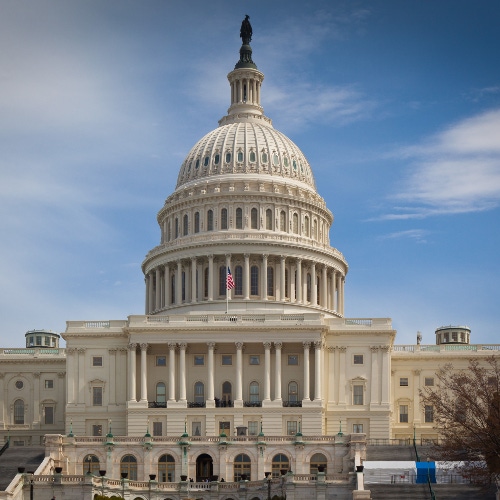Through their CTIA lobbying group, 5G operators are asking Congress to release spectrum in the 3.1-3.45GHz, 4.4-4.94GHz and 7.125–8.4GHz bands. However, there are several factors at play in that request.

With no additional spectrum auctions planned in the US, T-Mobile, Verizon, AT&T and other 5G wireless network operators will probably have to make do with the holdings they have for at least the next several years. That's significant because wireless network capacity is directly related to the amount of spectrum an operator can use – the more spectrum, the better and faster the network.
The FCC is currently auctioning parts of the 2.5GHz spectrum band for 5G. But after the auction is complete, federal regulators don't have any more spectrum lined up to release to US operators.
That has the nation's big 5G operators – through their main lobbying association, the CTIA – asking Congressional lawmakers to release more spectrum for 5G. And they're eyeing some specific spectrum bands: 3.1-3.45GHz, 4.4-4.94GHz and 7.125–8.4GHz.
"It is in our national interest to identify a spectrum pipeline of bands to be auctioned for exclusive use – once the current 2.5GHz band auction concludes, there will be no more 5G spectrum in the pipeline," warned Meredith Attwell Baker, the CEO of CTIA, in Congressional testimony this week.
Future of spectrum
The Senate's Subcommittee on Communications, Media, and Broadband held a hearing Tuesday to discuss the future of spectrum in the US. The hearing covered a wide variety of topics ranging from 5G interference with airplane altimeters to the FCC's authority to auction spectrum, which expires in September.
Figure 1:  (Source: Inge Johnsson/Alamy Stock Photo)
(Source: Inge Johnsson/Alamy Stock Photo)
However, the most critical issue for 5G network operators is the release of more licensed spectrum for exclusive use. Such spectrum is typically released through FCC auctions, and the most recent 5G auctions have generated more than $100 billion in winning bids. The eye-popping bids have helped underscore the importance of licensed spectrum for 5G, smartphones and the US cellular industry in general.
During the Trump administration, the FCC lined up a number of spectrum bands for 5G auctions. But so far, the Biden administration hasn't scheduled any new spectrum auctions.
"The federal government occupies 2/3 of the spectrum between 3-8.4GHz," said CTIA's Baker. "We should continue to rebalance government spectrum and commercial holdings – all while sustaining the federal mission. We can find ways to repurpose federal spectrum and use auction proceeds to repackage federal systems into more efficient state-of-the-art technology."
However, releasing that spectrum for 5G will require federal spectrum users, including the US military, to either release some of the spectrum they're currently using or share it with commercial interests.
The NTIA is the executive branch agency that's supposed to work with federal spectrum users in order to free up new spectrum for 5G. But the agency isn't doing that, according to Andrew Von Ah, director of physical infrastructure for the Government Accountability Office (GAO).
"We found that NTIA did not have a comprehensive documented process in place to plan its [spectrum] reallocation efforts from start to finish, even though reallocations are complex and can take many years to complete," Von Ah warned in his Senate testimony.
A new MOU
That may be changing, albeit slowly. On the same day of the Senate's hearing, the NTIA and FCC announced a new memorandum of understanding (MOU) that they said "will strengthen cooperation and collaboration between the agencies and help advance a whole-of-government approach to how we use and manage one of the nation's most important resources."
In terms of spectrum management specifically, the agencies promised to "meet at least monthly to exchange information. Where possible, the agencies will share their planned spectrum activities for the next 12 months."
The MOU is important following the recent dustup between the 5G industry and the airline industry. Despite the fact that the FCC auctioned C-band spectrum for 5G in the early part of 2021, the airline industry conducted a massive public relations campaign at the beginning of 2022 to prevent 5G operations in the C-band spectrum near airports. Airline operators are worried that 5G in that spectrum band will interfere with some aircraft altimeters.
Although the two sides have reached an agreement, it's possible that Verizon's C-band network near some airports won't launch until next year due to the situation.
That's the kind of spectrum problem that the FCC and NTIA are hoping to avoid with their new MOU.
Bigger factors
The spectrum debate is taking place amid several other pressing federal communications issues.
For example, the NTIA is already busy without needing to wrest spectrum from other government agencies, including the Department of Defense. The agency has been charged with distributing more than $40 billion for broadband access through the US government's Broadband Equity Access and Deployment program (BEAD) program.
The NTIA may also soon be tasked with administering another billion-dollar federal program. President Biden has said he plans to sign the $280 billion CHIPS and Science Act into law, which would provide funding to foster domestic chipset manufacturing.
Beyond the politics and logistics of spectrum management, there is also a question of whether demand for 5G spectrum will be sustained. AT&T and Verizon recently lowered their financial forecasts for 2022 amid rising inflation, and both companies have already spent a combined $80 billion on spectrum licenses in the past two years alone. Whether they have the financial wherewithal to buy even more spectrum – whether in 3.1-3.45GHz, 7.125–8.4GHz, or some other band – remains unclear.
Related posts:
— Mike Dano, Editorial Director, 5G & Mobile Strategies, Light Reading | @mikeddano
About the Author(s)
You May Also Like











